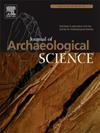对来自哥斯达黎加阿尔托德尔卡达尔和新科托尔遗址的前哥伦布考古陶瓷中灰色颜料的物理化学分析:首次发现中美洲的烧制骨混合物
IF 2.6
1区 地球科学
Q1 ANTHROPOLOGY
引用次数: 0
摘要
研究人员分析了哥斯达黎加Alto del Cardal和Nuevo Corinto遗址的陶瓷样品,这些样品的历史可追溯到公元700年至1500年(公元700年至1500年)。这些碎片出土于家庭、墓葬和车间环境中,显示了大量的社会生产活动,包括工具制造。陶瓷的厚度在9.25 ~ 12.46 mm之间。利用红外光谱、拉曼和扫描电子显微镜进行分析,发现了来自燃烧骨骼的生物羟基磷灰石、无定形碳、偏蒙脱石、石英、锐钛矿、赤铁矿和微量磁铁矿的存在。在哥斯达黎加、中美洲和墨西哥,从烧过的骨头中发现羟基磷灰石作为陶瓷颜料或涂层是前所未有的。这种技术表明,地层的高度非均质性和应用无滑移,使人想起在阿根廷南部记录的单一事件,以及在巴西和智利的类似做法。这种相似性使我们能够假设所研究的陶瓷在金属生产中的潜在用途。本文章由计算机程序翻译,如有差异,请以英文原文为准。
Physicochemical analysis of grey pigments from pre-Columbian archaeological ceramics from the sites of Alto del Cardal and Nuevo Corinto (Costa Rica): First identification of fired bone mixtures in Central America
Ceramic samples from the sites Alto del Cardal and Nuevo Corinto in Costa Rica, dating between 700 and 1500 CE (Common Era), were analysed. These sherds, excavated from domestic, funerary, and workshop contexts, exhibited substantial socio-productive activities, including tool manufacturing. The ceramics were characterized by significant thickness, ranging from 9.25 to 12.46 mm. Analysis using infrared spectroscopy, Raman, and Scanning Electron Microscopy revealed the presence of biogenic hydroxyapatite from fired bones, amorphous carbon, meta-smectite, quartz, anatase, hematite, and traces of magnetite. Finding hydroxyapatite from fired bone as a ceramic pigment or coating is unprecedented in Costa Rica, Central America, and Mexico. This technique suggests a high degree of layer heterogeneity and an application without slip, reminiscent of a singular occurrence documented in southern Argentina and analogous practices in Brazil and Chile. This similarity allowed us to hypothesize a potential use of the studied ceramics in metal production.
求助全文
通过发布文献求助,成功后即可免费获取论文全文。
去求助
来源期刊

Journal of Archaeological Science
地学-地球科学综合
CiteScore
6.10
自引率
7.10%
发文量
112
审稿时长
49 days
期刊介绍:
The Journal of Archaeological Science is aimed at archaeologists and scientists with particular interests in advancing the development and application of scientific techniques and methodologies to all areas of archaeology. This established monthly journal publishes focus articles, original research papers and major review articles, of wide archaeological significance. The journal provides an international forum for archaeologists and scientists from widely different scientific backgrounds who share a common interest in developing and applying scientific methods to inform major debates through improving the quality and reliability of scientific information derived from archaeological research.
 求助内容:
求助内容: 应助结果提醒方式:
应助结果提醒方式:


